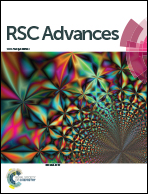Dual recognition of Al3+ and Zn2+ ions by a novel probe based on diarylethene and its application†
Abstract
We synthesized a new fluorescent probe 1O by attaching a diarylethene molecule to a functional group. The probe can be used to detect Al3+ and Zn2+ at the same time with high selectivity, and its detection limit is very low. When Al3+ was added, the fluorescence intensity was increased 310 folds, and was accompanied by a fluorescent color change from black to grass-green. Similarly, after the addition of Zn2+, the fluorescence intensity was enhanced 110 folds, with a concomitant color change from black to yellow-green. Moreover, based on the properties of 1O, we designed a logic circuit, and that also can be used for water sample testing.



 Please wait while we load your content...
Please wait while we load your content...